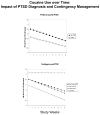Effect of PTSD diagnosis and contingency management procedures on cocaine use in dually cocaine- and opioid-dependent individuals maintained on LAAM: a retrospective analysis
- PMID: 20163389
- PMCID: PMC3472706
- DOI: 10.1111/j.1521-0391.2009.00025.x
Effect of PTSD diagnosis and contingency management procedures on cocaine use in dually cocaine- and opioid-dependent individuals maintained on LAAM: a retrospective analysis
Abstract
This randomized clinical trial retrospectively examined the effect of post-traumatic stress disorder (PTSD) and contingency management (CM) on cocaine use in opioid and cocaine dependent individuals maintained on high or low-dose LAAM randomly assigned to CM or a yoked-control condition. Cocaine-positive urines decreased more rapidly over time in those without PTSD versus those with PTSD in the noncontingency condition. In participants with PTSD, CM resulted in fewer cocaine-positive urines compared to the noncontingent condition. This suggests that CM may help improve the potentially worse outcomes in opioid- and cocaine-dependent individuals with PTSD compared to those without PTSD. (Am J Addict 2010;00:1-9).
Conflict of interest statement
The authors report no conflicts of interest.
Figures



Similar articles
-
Efficacy of dose and contingency management procedures in LAAM-maintained cocaine-dependent patients.Drug Alcohol Depend. 2005 Aug 1;79(2):157-65. doi: 10.1016/j.drugalcdep.2005.01.007. Drug Alcohol Depend. 2005. PMID: 16002025 Clinical Trial.
-
Comorbid major depressive disorder as a prognostic factor in cocaine-abusing buprenorphine-maintained patients treated with desipramine and contingency management.Am J Drug Alcohol Abuse. 2003 Aug;29(3):497-514. doi: 10.1081/ada-120023455. Am J Drug Alcohol Abuse. 2003. PMID: 14510037 Clinical Trial.
-
The impact of addiction medications on treatment outcomes for persons with co-occurring PTSD and opioid use disorders.Am J Addict. 2015 Dec;24(8):722-31. doi: 10.1111/ajad.12292. Epub 2015 Sep 21. Am J Addict. 2015. PMID: 26388539 Free PMC article. Clinical Trial.
-
Efficacy of opiate maintenance therapy and adjunctive interventions for opioid dependence with comorbid cocaine use disorders: A systematic review and meta-analysis of controlled clinical trials.Am J Drug Alcohol Abuse. 2009;35(5):339-49. doi: 10.1080/00952990903108215. Am J Drug Alcohol Abuse. 2009. PMID: 20180662
-
Posttraumatic stress disorder in opioid agonist therapy: A review.Psychol Trauma. 2018 Nov;10(6):636-642. doi: 10.1037/tra0000312. Epub 2017 Jul 31. Psychol Trauma. 2018. PMID: 28758767 Review.
Cited by
-
Prize-based contingency management for the treatment of substance abusers: a meta-analysis.Addiction. 2014 Sep;109(9):1426-36. doi: 10.1111/add.12589. Epub 2014 May 23. Addiction. 2014. PMID: 24750232 Free PMC article.
-
"I's" on the prize: A systematic review of individual differences in Contingency Management treatment response.J Subst Abuse Treat. 2019 May;100:64-83. doi: 10.1016/j.jsat.2019.03.001. Epub 2019 Mar 7. J Subst Abuse Treat. 2019. PMID: 30898330 Free PMC article.
-
Using incentives to reduce substance use and other health risk behaviors among people with serious mental illness.Prev Med. 2012 Nov;55 Suppl(Suppl):S54-60. doi: 10.1016/j.ypmed.2011.11.010. Epub 2011 Dec 9. Prev Med. 2012. PMID: 22197799 Free PMC article. Review.
-
Contingency Management Reduces Symptoms of Psychological and Emotional Distress among Homeless, Substance-dependent Men Who Have Sex with Men.Ment Health Subst Use. 2014 Nov 1;7(4):420-430. doi: 10.1080/17523281.2014.892897. Ment Health Subst Use. 2014. PMID: 25364379 Free PMC article.
-
Contingency management treatment for substance use disorders: How far has it come, and where does it need to go?Psychol Addict Behav. 2017 Dec;31(8):897-906. doi: 10.1037/adb0000287. Epub 2017 Jun 22. Psychol Addict Behav. 2017. PMID: 28639812 Free PMC article. Review.
References
-
- Rounsaville BJ, Weissman MM, Kleber H, Wilber C. Heterogeneity of psychiatric diagnosis in treated opiate addicts. Arch Gen Psychiatry. 1982;39:161–166. - PubMed
-
- Dansky B, Saladin M, Brady K, Kilpatrick D, Resnick H. Prevalence of victimization and posttraumatic stress disorder among women with substance use disorders. International Journal of Addiction. 1995;30:1079–1099. - PubMed
-
- Fullilove MT, Fullilove RE, Smith M, Winkler K, et al. Violence, trauma, and post-traumatic stress disorder among women drug users. J Trauma Stress. 1993;6:533–543.
-
- Najavits L, Gastfriend D, Barber J, et al. Cocaine dependence with and without PTSD among subjects in the national institute on drug abuse collaborative cocaine treatment study. Am J Psychiatry. 1998;155:214–219. - PubMed
-
- McLellan AT, Luborsky L, Woody GE, O’Brien CP, Druley KA. Predicting Response to alcohol and drug abuse treatments: role of psychiatric severity. Arch Gen Psychiatry. 1983;40:620–625. - PubMed
Publication types
MeSH terms
Substances
Grants and funding
LinkOut - more resources
Full Text Sources
Medical

